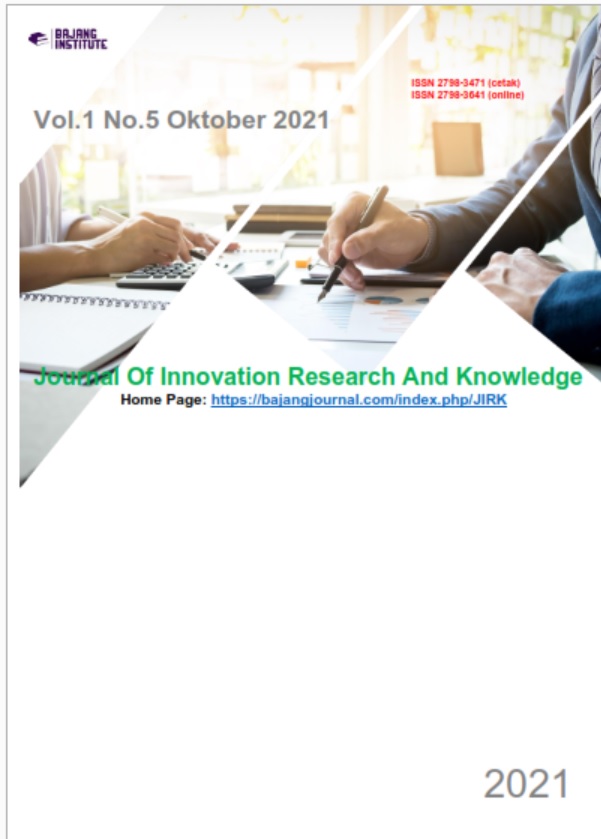THE RELATIONSHIP BETWEEN WORKLOAD AND EDUCATOR STRESS
DOI:
https://doi.org/10.53625/jirk.v1i5.460Keywords:
Work Stress, WorkloadAbstract
The purpose of this study was to empirically examine the relationship between workload and work stress on educators. This research is an analytic study with a cross sectional approach. The population used in this study were all 31 Padang AMSS education staff in 2019. The sampling technique is using a saturated sample. Techniques for collecting data were field studies, namely observation and interviews and distributing questionnaires. The research variable consisted of 2 types, namely the independent variable in the form of workload, and the dependent variable in the form of work stress. The sampling technique was total sampling because the total population consisted of 31 educators and 1 leader. The research used survey techniques for descriptive studies using the SPSS version. 18.0. The instrument used is a questionnaire for workload and work stress variables with five Likert scales ranging from 1 to 5 (strongly disagree to strongly agree). Data was collected using a workload scale and a work stress scale. the results of research that have been carried out concluded that there is a significant relationship between workload and work stress for educators at AMSS Padang. This is indicated by the value of p = 0.00 (< 0.05), meaning that if the workload on employees increases, the stress level of employees will also increase so as to avoid various obstacles in serving the needs of the academic community, especially AMSS Padang students. For leaders, it is hoped that they will be able to provide continuous supervision in a clear division of work so that educators do not feel burdened with the tasks and responsibilities given so that stress at work can be minimized
References
Ahsan, N., Abdullah, Z., Fie, DYG, & Alam, SS (2009). A study of job stress on job satisfaction among university staff in Malaysia: Empirical study. European Journal of Social Sciences, 8 (1), 121–131.
Altaf, AMAA (2011). Moderating Affect of Workplace Spirituality on the Relationship of Job Overload and Job Satisfaction. Journal of Business Ethics, 93–99. https://link.springer.com/article/10.1007/s10551-011-0891-0
Beehr, TA (1976). Perceived Situational Moderators of the Relationship between Subjective Role Ambiguity and Role Strain. Journal of Applied Psychology, 6, 35–40.
Cropanzano, R., Howes, JC Grandey, AA, & Toth, P. (1997). The Relation-ship of Organizational Politics and Support to Work Behaviors, Attitu-des, and Stress. Journal of Organizational Behavior., 18, 159-180.
Crouter, AC, Bumpus, MF, Head, MR, & McHale, SM (2004). Implications of Overwork and Overload for the Quality of Men's Family Relationships. Journal of Mariagge and Family. https://doi.org/https://doi.org/10.1111/j.1741-3737.2001.00404.x
Cynthia L. Cordes, TWD (1993). Academy of Management Review. Academy of Management Review, 18. https://doi.org/https://doi.org/10.5465/amr.1993.9402210153
Dasgupta, PR (2013). Workload volatility on employee performance and motivation significance: IT sector. Journal of Business and Management Science.
Dhelvia, R. (2018). The Influence Workload and Competence on Employee Performance in PT X Finance. Advances in Social Science, Education and Humanities Research, 225 (Icobest), 135–138. https://doi.org/10.2991/icobest-18.2018.30
Elizabeth Scott, M. (2009). Common Signs and Symptoms of Too Much Stress. About.Com Guide. https://www.verywellmind.com/common-symptoms-of-too-much-stress-3145238
Gawron, VJ (2008). Human Performance, Workload, and Situational Awareness Measures Handbook (2nd ed.). CRC Press Taylor & FrancisGroup.
Handoko. (2009). Personnel and Human Resource Management (2nd ed.). BPFE.
Hendrix, WH, Ovalle, NK, & Troxler, RG (1985). Behavioral and Physiology-cal Consequences of Stress and Its Antecedent Factors. Journal of Ap-Plied Psychology, 70 (1), 188–201.
Irvan, RM, & Heryanto. (2019). The Effect Of Competence And Workload On Motivation And Its Impact On The Performance Of Civil Servants At The Regional Secretariat Of The Regency Of Dharmasraya. Archives of Business Research, 7 (5), 134–142.
Ivancevich, JM; Mattson, MT; Preston. (1982). Occupational Stress, Type A a behavior, and Psychological Well Being. Accademy of Management Journal, 25. (2), 373–391.
Luthans, F. (2006). Organizational Behavior (10th ed.). Andi Offset.
Moore, JE (2000). One Road to Turnover: An Examination of Work Exhaustion in Technology Professionals. MIS Quarterly, 24 (1). https://www.jstor.org/stable/3250982?seq=1
Muchinsky, P. (1997). Psychology applied to work: An introduction to industrial and organizational psychology Pacific Grove ((5th Ed.)). CA: Brookes / Cole Publishers.
Muchlas, M. (2008). Organizational Behavior (Prints to). Gadjah Mada University Presso.
Nadialis, EC; Nugrohoseno D. (2014). Relationship between Age, Work Period and Workload with Employee Work Stress. Journal of Management Science (JIM), 2 (2).
Nurmalasari, W. (2013). The Influence of Work Environment and Workload on Work Stress of Nurses at Regional General Hospital Arifin AchmadPekanbaru. Journal of Management, 1–10. https://www.academia.edu/28847278/
Rizky, D., & Afrianty, TW (2018). The Effect of Workload on Work Stress with Work Life Balance as an Intervening Variable (Study at the Social Service Office of East Java Province, Surabaya). Journal of Business Administration, 61.
Robbins, S. (2006). Organizational Behavior (Indonesian Language). Prenhallindo.
Robbins, SP (2008). Organizational Behavior. (9th ed.). Prentice Hall International, Inch ,.
Romadhoni, C., Asmony, T., & Suryatni, M. (2015). Effect of workload, work environment, and social support on. Khizanah Al-Hikmah, 3 (2), 125–145. https://doi.org/10.24252/kah.v3i2a3
Russo, J., & Vitaliano, P. (1995). Life events as correlates of burden in spouse caregivers of persons with Alzheimers disease. Experimental Aging Research, 21, 273-294.
Stranks, J. (2005). Stress at Work Management and Prevention. Elsevier Butterworth-Heinemann.
Suwatno, DGT (2014). HR Management in Public and Business Organizations. Alfabeta.
Ursprung, A.. (1986). Incidence and correlates of burnout in residential service settings pp. Rehabilitation Counseling Bulletin, 29, 225–239.
Yaslis, I. (2000). Human Resource Planning at PT (Theory, Methods and Formulas). Center for Economic Information Studies, FKM UI Depok.
Zetli, S. (2019). The Relationship between Mental Workload and Work Stress in Educational Personnel in Batam City. Industrial Systems Engineering, 4 (2), 63–70. ejournal.upbatam.ac.id/index.php/rsi/article/download/1061/720 ·













